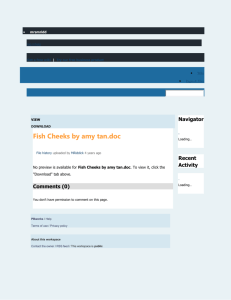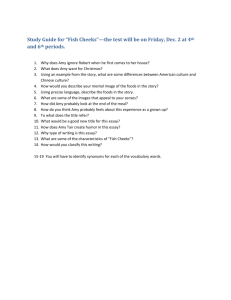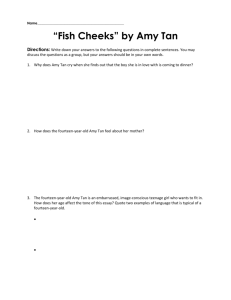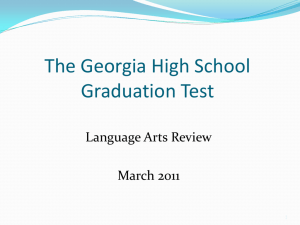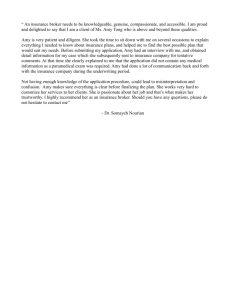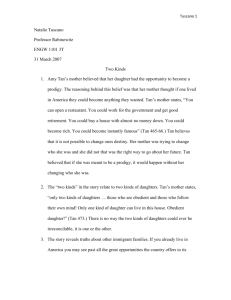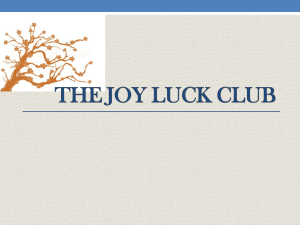The Joy Luck Club Reading Overview
advertisement
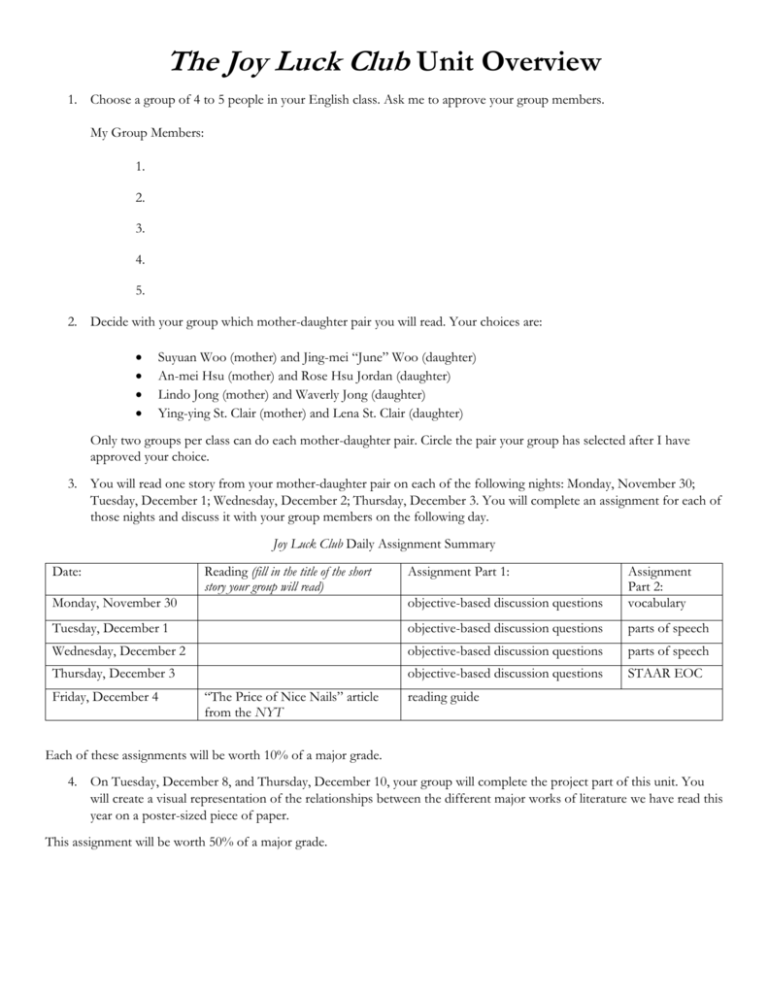
The Joy Luck Club Unit Overview 1. Choose a group of 4 to 5 people in your English class. Ask me to approve your group members. My Group Members: 1. 2. 3. 4. 5. 2. Decide with your group which mother-daughter pair you will read. Your choices are: Suyuan Woo (mother) and Jing-mei “June” Woo (daughter) An-mei Hsu (mother) and Rose Hsu Jordan (daughter) Lindo Jong (mother) and Waverly Jong (daughter) Ying-ying St. Clair (mother) and Lena St. Clair (daughter) Only two groups per class can do each mother-daughter pair. Circle the pair your group has selected after I have approved your choice. 3. You will read one story from your mother-daughter pair on each of the following nights: Monday, November 30; Tuesday, December 1; Wednesday, December 2; Thursday, December 3. You will complete an assignment for each of those nights and discuss it with your group members on the following day. Joy Luck Club Daily Assignment Summary Date: Monday, November 30 objective-based discussion questions Assignment Part 2: vocabulary Tuesday, December 1 objective-based discussion questions parts of speech Wednesday, December 2 objective-based discussion questions parts of speech Thursday, December 3 objective-based discussion questions STAAR EOC Friday, December 4 Reading (fill in the title of the short story your group will read) “The Price of Nice Nails” article from the NYT Assignment Part 1: reading guide Each of these assignments will be worth 10% of a major grade. 4. On Tuesday, December 8, and Thursday, December 10, your group will complete the project part of this unit. You will create a visual representation of the relationships between the different major works of literature we have read this year on a poster-sized piece of paper. This assignment will be worth 50% of a major grade. NAME: DATE: PERIOD: JLC Reading: Monday, November 30 TITLE OF STORY: _______________________________________________ Part 1: As you read, come up with two questions based on some of the reading objectives we have covered in class this semester. Possible objectives include: allusion foreshadowing sentence style analysis imagery suspense author’s purpose inference theme characterization irony conflict plot evaluation point-of-view You should generate your questions on your own – without the aid of your group members or the Internet. Answer your question yourself. Then, in class, ask your group about your questions, and record notes about what they say. Question 1: Objective: My Response: Notes on Group Members’ Responses: Question 2: Objective: My Response: Notes on Group Members’ Responses: Part 2: As you read, identify five words you did not know before. Fill out the chart for those words. This portion of your assignment should be completed independently. Word 1: Sentence from JLC: Page #: ____ Definition: Connotations: Original Sentence Using Word: Word 2: Sentence from JLC: Page #: ____ Definition: Connotations: Original Sentence Using Word: Word 3: Sentence from JLC: Page #: ____ Definition: Connotations: Original Sentence Using Word: Word 4: Sentence from JLC: Page #: ____ Definition: Connotations: Original Sentence Using Word: Word 5: Sentence from JLC: Page #: ____ Definition: Original Sentence Using Word: Connotations: JLC Reading: Tuesday, December 1 TITLE OF STORY: _______________________________________________ Part 1: As you read, come up with two questions based on some of the reading objectives we have covered in class this semester. Possible objectives include: allusion foreshadowing sentence style analysis imagery suspense author’s purpose inference theme characterization irony conflict plot evaluation point-of-view You should generate your questions on your own – without the aid of your group members or the Internet. Answer your question yourself. Then, in class, ask your group about your questions, and record notes about what they say. Question 1: Objective: My Response: Notes on Group Members’ Responses: Question 2: Objective: My Response: Notes on Group Members’ Responses: Part 2: Define the following parts of speech and identify two examples from your reading selection. Your group members may help you on the second column, but not the third or fourth. Part of Speech noun proper noun common noun count noun non-count noun verb helping verb linking verb transitive verb intransitive verb emphatic form of verb adjective adverb adverb that does not end in -ly singular pronoun plural pronoun correlative conjunction subordinating conjunction preposition definite article indefinite article interjection Definition Example 1 (give page number) Example 2 (give page number) JLC Reading: Wednesday, December 2 TITLE OF STORY: _______________________________________________ Part 1: As you read, come up with two questions based on some of the reading objectives we have covered in class this semester. Possible objectives include: allusion foreshadowing sentence style analysis imagery suspense author’s purpose inference theme characterization irony conflict plot evaluation point-of-view You should generate your questions on your own – without the aid of your group members or the Internet. Answer your question yourself. Then, in class, ask your group about your questions, and record notes about what they say. Question 1: Objective: My Response: Notes on Group Members’ Responses: Question 2: Objective: My Response: Notes on Group Members’ Responses: Part 2: Below is a list of ten rules relating to parts of speech that writers should follow to communicate effectively. Find an example of how Amy Tan follows this rule in the selection you have read. Then revise the sentence to demonstrate breaking the rule. Writers should maintain consistency of tense to avoid confusing the reader. Amy Tan’s Sentence: Page #: ___ Incorrect Revision: Writers should use gender-neutral nouns whenever possible to avoid bias. Amy Tan’s Sentence: Page #: ___ Incorrect Revision: Writers should ensure that their pronouns match their antecedents in number and gender. Amy Tan’s Sentence: Page #: ___ Incorrect Revision: Writers should use the subject and object forms of pronouns correctly, depending on the pronoun’s function in the sentence. Amy Tan’s Sentence: Page #: ___ Incorrect Revision: Writers should ensure that proper nouns are correctly capitalized. Amy Tan’s Sentence: Page #: ___ Incorrect Revision: Writers should correctly spell the plural forms of nouns. Amy Tan’s Sentence: Page #: ___ Incorrect Revision: Writers should ensure that the form of the verbs that they use agree with the number (singular or plural) of their subject. Amy Tan’s Sentence: Page #: ___ Incorrect Revision: Writers should use the correct forms of irregularly conjugated verbs. Amy Tan’s Sentence: Page #: ___ Incorrect Revision: Writers should use adverbs, not adjectives, to describe verbs. Amy Tan’s Sentence: Page #: ___ Incorrect Revision: Writers should use precise nouns and verbs instead of vague nouns and verbs with modifiers (adverbs and adjectives). Amy Tan’s Sentence: Page #: ___ Incorrect Revision: JLC Reading: Thursday, December 3 TITLE OF STORY: _______________________________________________ Part 1: As you read, come up with two questions based on some of the reading objectives we have covered in class this semester. Possible objectives include: allusion foreshadowing sentence style analysis imagery suspense author’s purpose inference theme characterization irony conflict plot evaluation point-of-view You should generate your questions on your own – without the aid of your group members or the Internet. Answer your question yourself. Then, in class, ask your group about your questions, and record notes about what they say. Question 1: Objective: My Response: Notes on Group Members’ Responses: Question 2: Objective: My Response: Notes on Group Members’ Responses: Part 2: Based on the selection you read, you will create two multiple choice questions, one short answer response question, and one thematic essay prompt. (You do not need to answer these questions – just create them.) A. Multiple Choice Questions Effective multiple choice questions ask the reader to think critically about the text and make inferences based on evidence – not just recall facts. The incorrect answer choices for a multiple choice question should be plausible, not ridiculous; incorrect answer choices are often partially, but not wholly, correct. Your multiple choice questions should be based on the objectives listed on the front of this page. 1. ___________________________________________________________________________________________ ___________________________________________________________________________________________ A. ________________________________________________________________________________________ B. ________________________________________________________________________________________ C. ________________________________________________________________________________________ D. ________________________________________________________________________________________ 2. ___________________________________________________________________________________________ ___________________________________________________________________________________________ A. ________________________________________________________________________________________ B. ________________________________________________________________________________________ C. ________________________________________________________________________________________ D. ________________________________________________________________________________________ B. Short Answer Response Question An effective short answer response question is open-ended. It asks the reader to interpret the piece of literature. It should have multiple possible answers that can be supported by text evidence. Short Answer Response Question: ______________________________________________________________________ _________________________________________________________________________________________________ C. Expository Essay Prompt An expository essay prompt deals with a universal, abstract theme that can be answered through personal experience, literature, history, or current events. Base your prompt on the issues inside of the selection you read from JLC. READ the following quotation. Find a quotation that deals with the theme of your prompt. THINK about ______________________________________________________. WRITE an essay explaining ____________________________________________ __________________________________________________________________. Complete the statement to ask the reader to think about one aspect of your theme. Complete the prompt by asking the reading to explain something about an abstract theme. Pre-AP ELA 1 Fall Semester Literature Visual Representation Your group will create a visual product on a poster-sized sheet of paper to explore and explain the relationships between the major works we have read this semester. Your product must include: Your product may include: The Odyssey Dracula The Hot Zone The Joy Luck Club The Hunger Games The Alchemist I Am Malala The relationships that you explore could encompass: theme genre geography plot style history conflict patterns characters collage comic strip menu advertisement something else approved me The form that your product takes could be a: diagram chart map illustration You must create a rough draft of your product before I will allow you to start working on the final product. I will probably have some suggestions that I want you to incorporate. I will evaluation your product using the rubric below: Component depth of analysis and connections text evidence visual order/ visual logic creativity professionalism of presentation Explanation I need to see evidence of thoughtful reflection on the literature that we have read this year. If you tell me that The Joy Luck Club and I Am Malala are related because they both have female protagonists, that is a superficial connection. If you explore how those protagonists face a unique set of challenges because of their gender, you’re on to an interesting line of thinking. You are probably thinking, “Do we have to have text evidence for everything in this class?” Yes. And not just in this class – in every text-based class, for the rest of your lives. You need at least one quotation for every work of literature incorporated into your product. Try to choose quotations that are particularly meaningful and memorable. Just as the order of the words in the sentence structures their meaning, the ways in which you choose to organize your space visually will shape the message of your product. The different pieces of your product need to be integrated into a meaningful whole. Do not just put four different pictures in random order onto your paper. If the instructions for this product are vague, that is because I want to give you the freedom to develop a work that goes beyond what I can possibly imagine. Much of what we do in this class – grammar, structured writing, text analysis – is subject to strict rules. I’m giving you a break from those rules in the hope that you will come up with something weird and cool and delightful – something totally unlike what the rest of the class is doing. WHAT I DON’T WANT: Your product looks like you paid a chimpanzee in bananas to complete it for you. The text is difficult to read, the visuals are sloppy, there is little elaboration, the paper is stained and crumpled. WHAT I DO WANT: Papers that I can put up in the hallway that will make other teachers jealous. Carefully crafted work that is visually pleasing. Possible Points


